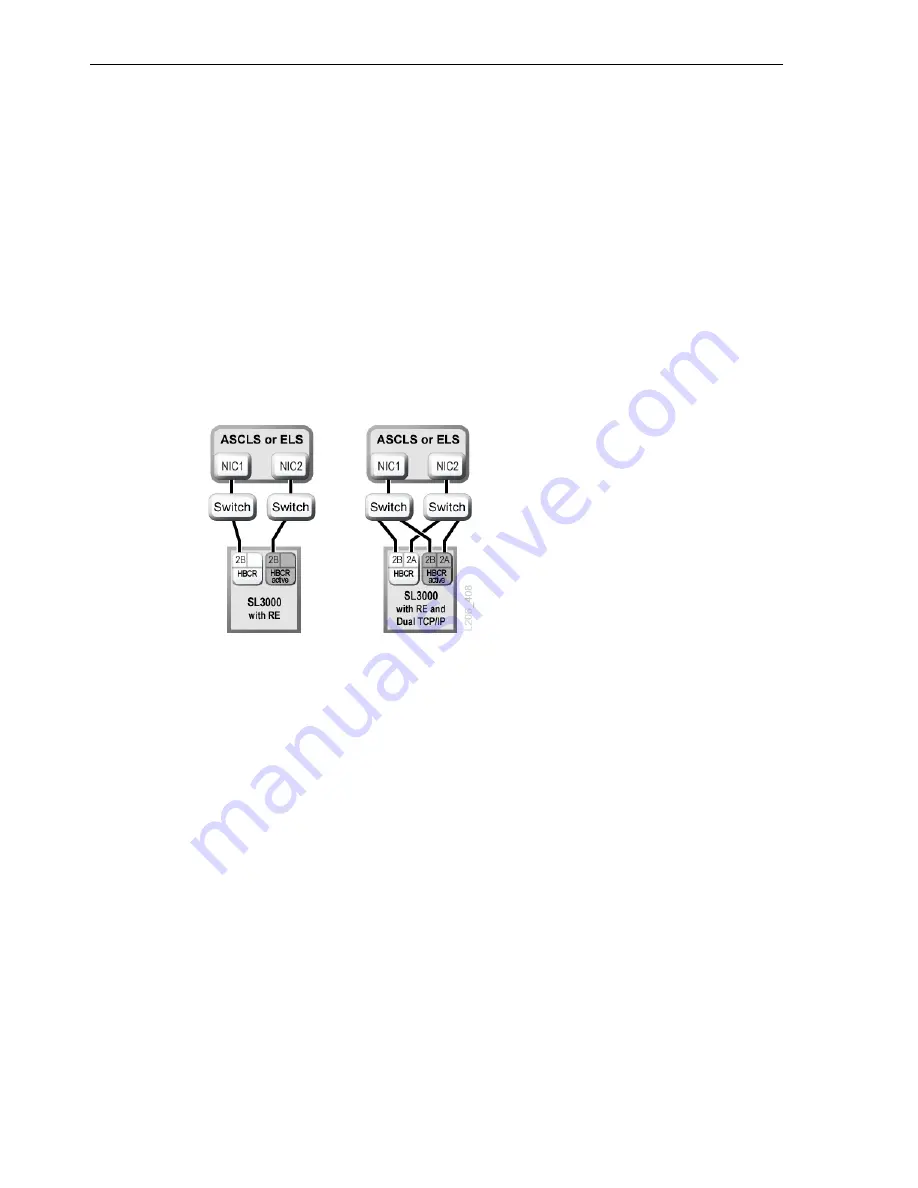
Redundant Electronics Configuration Examples
B-2
StorageTek SL3000 Library Guide
■
Hardware activation file (see
"Activating Optional Features"
■
HLI host with TCP/IP or FC-SCSI host using ACSLS (see
on page 8-4). RE is not available to hosts using a
native FC-SCSI interface.
Redundant Electronics Configuration Examples
Each library controller card requires its own unique IP address. If the dual TCP/IP
feature is active on the library, each card requires two unique IP addresses: one for the
primary port 2B and one for the secondary port 2A. Therefore, a library with RE and
dual TCP/IP requires four unique IP addresses.
On each controller card, port 2B and 2A must be on different broadcast domains.
However, port 2B on the active card and port 2B on the standby card can be on the
same broadcast domain. The same is true for the 2A ports.
Figure B–1
Redundant Electronics Configuration Examples
For more information about dual TCP/IP, see
What Occurs During a Failover
In a failover, the active library controller attempts to complete all in-process jobs and
copies the cartridge database to the standby controller card. If the database cannot be
copied (usually only in a sudden failure), you must perform an audit after failover (see
on page 13-1). The library returns any in-transit cartridges to
their home slots. The library places any cartridges it cannot return to a home slot in a
system slot for host recovery (see the host software documentation).
After all in-process jobs complete or time out, the cards switch roles. The standby
controller becomes active and the previously active controller becomes the standby. If
the previously active controller cannot bring up the standby software, the controller
enters a fault state.
Effect of a Failover on Users
■
Users of tape management software (Symantec or Virtual Storage Manager) do not
see an interruption.
■
HLI host applications queue requests during the failover process for completion
after the failover switch. For ACSLS, only mount and dismount requests are
affected (see the host software documentation).
Summary of Contents for StorageTek SL3000
Page 1: ...1 StorageTek SL3000 Library Guide E20875 15 December 2018...
Page 16: ...xvi...
Page 50: ...Ordering 1 32 StorageTek SL3000 Library Guide...
Page 62: ...Installation Tools 2 12 StorageTek SL3000 Library Guide...
Page 66: ...Installing Web launched SLC 3 4 StorageTek SL3000 Library Guide...
Page 74: ...Resolving Orphaned Cartridges Caused by Capacity Changes 6 4 StorageTek SL3000 Library Guide...
Page 88: ...Configuring Dual TCP IP 8 8 StorageTek SL3000 Library Guide...
Page 112: ...Stopping a Validation 12 4 StorageTek SL3000 Library Guide...
Page 124: ...Monitoring Library Events 15 6 StorageTek SL3000 Library Guide...
Page 128: ...Rebooting the Library 16 4 StorageTek SL3000 Library Guide...
Page 166: ...Downgrading Firmware D 4 StorageTek SL3000 Library Guide...
Page 183: ...Wall Diagrams Library Addressing Reference E 17 Figure E 14 Base Module Rear Wall...
Page 185: ...Wall Diagrams Library Addressing Reference E 19 Figure E 16 DEM Front Wall...
Page 186: ...Wall Diagrams E 20 StorageTek SL3000 Library Guide Figure E 17 DEM Front Wall continued...
Page 187: ...Wall Diagrams Library Addressing Reference E 21 Figure E 18 DEM Rear Wall...
Page 188: ...Wall Diagrams E 22 StorageTek SL3000 Library Guide Figure E 19 DEM Rear Wall continued...
Page 190: ...Wall Diagrams E 24 StorageTek SL3000 Library Guide Figure E 21 Cartridge Expansion Module Rear...
Page 191: ...Wall Diagrams Library Addressing Reference E 25 Figure E 22 Parking Expansion Module Left...
Page 192: ...Wall Diagrams E 26 StorageTek SL3000 Library Guide Figure E 23 Parking Expansion Module Right...
Page 193: ...Wall Diagrams Library Addressing Reference E 27 Figure E 24 Access Expansion Module Left...
Page 194: ...Wall Diagrams E 28 StorageTek SL3000 Library Guide Figure E 25 Access Expansion Module Right...
Page 202: ...Label Care F 8 StorageTek SL3000 Library Guide...
















































